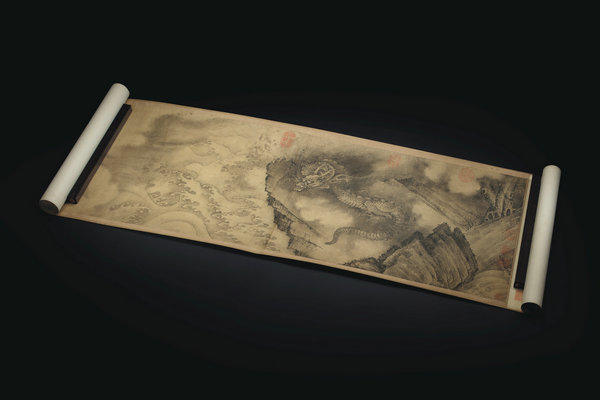
Bronze ritual vessels and 13th-century painting Six Dragons will be put under the hammer in New York. [Photo/China Daily]
Four 3,000-year-old Chinese bronze ritual vessels are among 31 Chinese works of art to be auctioned at a New York sale on Wednesday night.
The items to be sold by Christie's are from the collection of the Osaka-based Fujita Museum, which was founded in 1954 to display the collection of Japanese entrepreneur Denzaburo Fujita (1841-1912) and his sons.
The four vessels, each with a presale estimate surpassing $4 million, were used as wine containers during ceremonies in the late Shang Dynasty (c. 16th century-11th century BC). They are seen as examples of refined bronze-working skills, and three of them are believed to have been excavated in the city of Anyang, in Henan province.
A square fangzun vessel features mythical creatures on its four shoulders. They look like birds that have hooked beaks, wings and curled tails, while notably, they each wear a horned monster mask. Hybrids combining the features of imagined and real animals like this were a common way for the Shang people to create motifs on bronze objects.
Another highlight is a square fanglei vessel standing 63.5 centimeters.
Among the 45 such vessels in existence, the largest one known is Min Fanglei, 88 cm high, which is now at the Hunan Provincial Museum.
The return of Min Fanglei to its birthplace in Hunan made headlines in 2014.
The vessel was supposed to be auctioned at Christie's in New York. But a group of Chinese buyers from Hunan purchased it in a private deal before the sale, so that it could be reunited with its lid, which has been at the Hunan museum for decades.
The sale of the Fujita collection will also see six classical ink-brush paintings, which used to be with Emperor Qianlong of the Qing Dynasty (1644-1911). They were cataloged in Shiqu Baoji, the inventory of the Qing's imperial collection of top-notch Chinese paintings and calligraphic pieces.
Among them is a 4.4-meter-long scroll titled Six Dragons by 13th-century painter Chen Rong. It shows six powerful dragons at sea.
Jonathan Stone, Christie's international chairman of Asian Art, says the Fujita family had been collecting both Chinese and Japanese works of art for almost 100 years, and it led to the setting up of a very distinguished museum in Japan.
He tells China Daily that the proceeds from the sale will fund the refurbishment of the museum.
The sale is a highlight of the ongoing Asia Week New York. The annual event sees galleries, museums and auction houses team up to organize Asian art related events.
The Asia Week auctions of Chinese works of art have recently attracted an influx of Chinese collectors and dealers.
Stone says that Chinese buyers are now well-educated, knowledgeable and sophisticated.
The upcoming sale may be a shopping carnival for deep-pocketed Chinese buyers. But antique experts advise caution.
Yu Chenglong, a bronze specialist at Beijing's National Museum of China, says that Japanese buyers started to accumulate Chinese bronze ware in the 1920s and built up a systematic collection of high-quality bronzes.
"Bronze ware symbolize a nation's etiquette and power. They are top Chinese works of art," says Yu. "It is sad if we should buy back our lost treasures at high prices."
Zhou Ya, a researcher at the Shanghai Museum, told Thepaper.cn that the sale of the Fujita collection reflects a hot market for Chinese antiques, but he hopes that the bronze ware will be sold to people who are truly interested in them, not those who seek only short-term returns.
